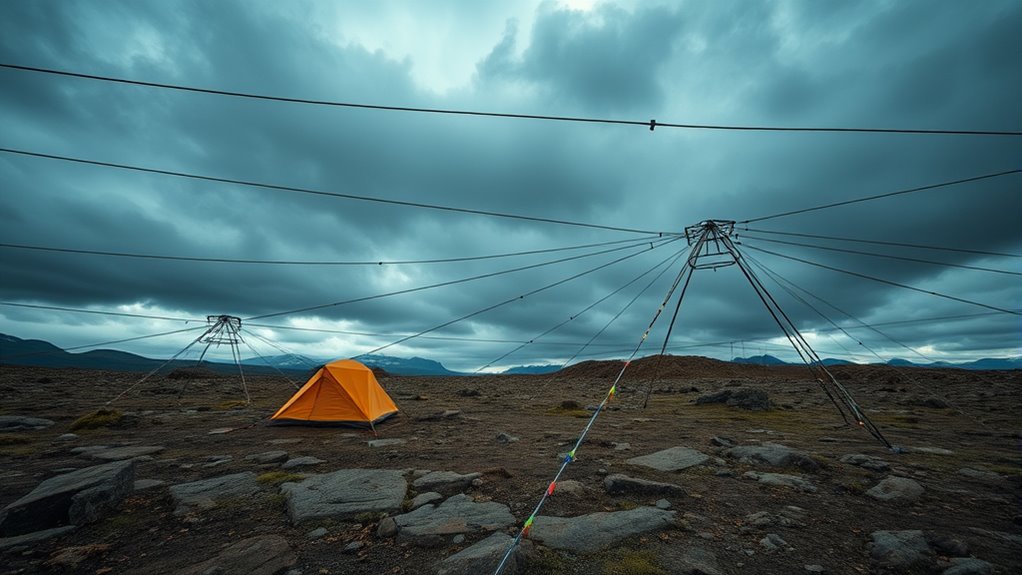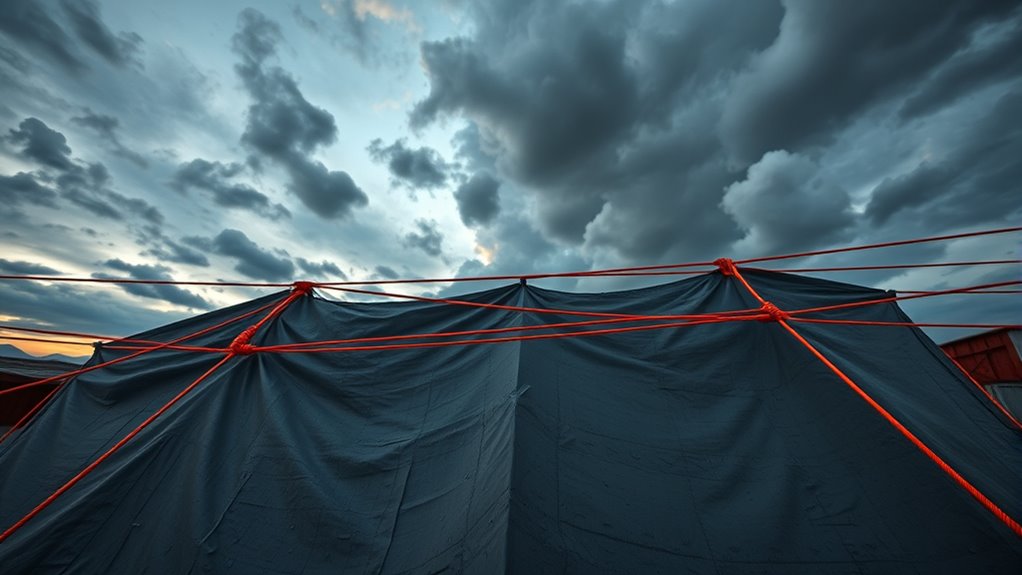To ensure your storm setup stays secure, follow proven guyline patterns like triangulated anchors and use tensioning devices such as turnbuckles for ideal tension control. Choose high-tensile-strength materials and create firm anchor points deep in the ground or on sturdy objects. Proper knot techniques like bowlines help prevent loosening, while maintaining roughly 45-degree angles improves stability. If you implement these engineer-approved strategies, you’ll build a resilient system—discover more ways to strengthen your setup as you go.
Key Takeaways
- Use triangulated guyline patterns to evenly distribute forces and enhance stability during storms.
- Anchor guylines at approximately 45 degrees to maximize tension and resistance to wind forces.
- Select high-tensile-strength materials for cords and ensure secure, proper knots like bowline or taut-line hitch.
- Incorporate tensioners or turnbuckles for quick, precise tension adjustments under changing storm conditions.
- Regularly inspect and re-tension lines and anchors to maintain optimal stability and prevent failure.

Setting up for a storm might seem overwhelming, but knowing a few key secrets can make the process much easier. One of the most essential aspects is understanding how to maximize the tensile strength of your guyline setup. Tensile strength refers to the ability of your lines to withstand pulling forces without breaking. When you’re preparing for high winds, you need to guarantee your guylines are rated for the expected load. Using high-quality materials with superior tensile strength provides a sturdy foundation, preventing failures that could compromise your entire setup. Remember, the strength of your anchor points is only as good as the lines attached to them, so don’t cut corners with inferior cords or strings.
Equally important is employing the right anchoring techniques. Proper anchoring ensures your guylines remain taut and secure, even under intense wind pressure. You want to dig your anchors deep into the ground or attach them to sturdy fixed objects, such as large trees or heavy-duty stakes. The key is to create a firm hold that resists shifting or pulling out. When setting your anchors, angle your guylines at approximately 45 degrees from the ground—this distributes the force evenly and maximizes holding power. Using multiple anchors in a triangulated pattern enhances stability, providing balance and reducing the risk of the lines slipping or loosening. It’s essential to double-check each connection point, making sure knots are tight and secure. Techniques like bowline knots or taut-line hitches are preferred because they maintain tension and are easy to adjust on the fly. Additionally, understanding the tensile strength of your lines helps prevent unexpected failures during storms.
Another tip is to incorporate tensioning devices such as tensioners or turnbuckles. These tools allow you to fine-tune the tension of your guylines quickly, ensuring they stay tight without requiring constant re-adjustment. Proper tensioning is important because loose lines can flap wildly, creating vibrations that weaken the entire setup. Conversely, overly tight lines can cause stress on the anchor points, risking damage or failure. Regularly inspecting your setup before the storm hits can help identify weak spots or slack lines, so you can tighten or re-anchor as needed. When combined, selecting lines with high tensile strength and applying sound anchoring techniques form the backbone of a reliable, storm-ready setup.
Frequently Asked Questions
How Do Different Terrain Types Affect Guyline Pattern Choices?
You need to consider terrain considerations when choosing guyline patterns because different surfaces impact stability. On rocky ground, you might opt for more secure, angled patterns, while soft soil requires deep stakes and wider setups. Material selection is also crucial; use durable, high-tensile cords for tough terrains, and lightweight options for easier surfaces. Adjust your guyline pattern based on terrain to guarantee maximum stability and safety during your setup.
What Materials Are Best for High-Wind Storm Setups?
Think of your storm setup like a sturdy ship steering through fierce winds. The best anchor materials, like high-strength nylon or steel, act as your ship’s hull, providing resilience. Use durable, weather-resistant cords to guarantee tension adjustment stays firm during gusts. These materials help your guyline system withstand high winds, keeping your shelter stable and secure. Choose quality, weatherproof anchors to weather any storm, just as a ship braves the storm with a solid hull.
How Can I Quickly Adjust Guyline Tension During a Storm?
To make quick tension adjustments during a storm, keep your guylines pre-tied with storm-ready knots like the taut-line hitch or loop-and-lock. These knots allow you to easily tighten or loosen your guylines without needing to untie and retie. Practice adjusting tension beforehand so you can swiftly respond when high winds hit. This way, you stay storm ready, maintaining stability and safety with minimal effort.
Are There Specific Safety Precautions for Storm Guyline Installations?
A stitch in time saves nine, so take safety seriously. When installing storm guylines, always prioritize ground anchoring to prevent slips or collapses. Use high-quality stakes and secure them properly. During emergencies, be ready to adjust tension quickly, but never compromise safety for speed. Keep clear of tensioned lines, and regularly inspect them for wear or damage. Proper emergency preparedness guarantees your setup stays secure and safe during fierce storms.
How Do Weather Forecasts Influence Setup Planning and Adjustments?
You rely on weather forecasts to refine storm preparedness planning, especially since weather prediction accuracy varies. When forecasts predict storm conditions, you adjust your guyline setups for maximum stability and safety. By monitoring updates, you can tighten or loosen lines, reposition anchors, or delay installation to guarantee your setup withstands changing weather. Staying adaptable based on forecast accuracy helps protect your equipment and people during unpredictable storm events.
Conclusion
Now that you know these tried-and-true guyline patterns, you’re better equipped to handle any storm that comes your way. Remember, a stitch in time saves nine, so applying these secrets early can save you a lot of trouble later. Don’t wait for the storm to hit—be proactive, plan your setup, and stay one step ahead. With this knowledge, you’re ready to weather any weather, no matter how fierce the skies get.










